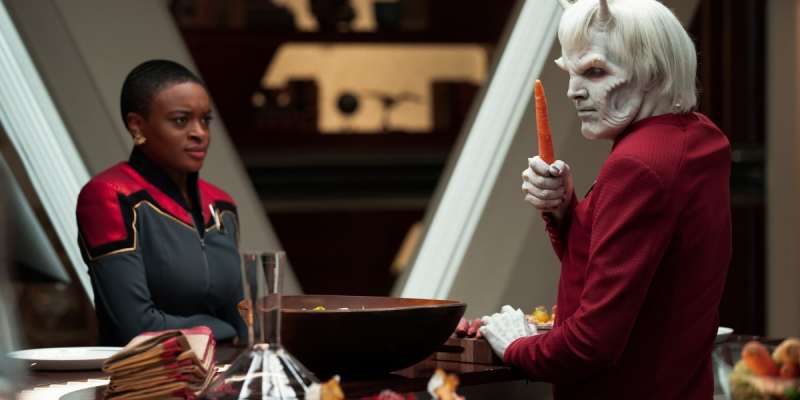This discussion and review contains spoilers for Star Trek: Strange New Worlds episode 2, “Children of the Comet,” but it also has a whole lot of talk about Michael Piller and Voyager allusions. Buckle up, folks.
When Michael Piller found himself in charge of Star Trek: The Next Generation in late 1989, he would radically redefine the Star Trek franchise.
Piller had originally been tasked by his old friend Maurice Hurley with writing a few scripts for the third season of the deeply troubled Star Trek spinoff, which had suffered some attrition in the writers’ room. However, Piller quickly found himself thrown in the deep end when the new showrunner, Michael I. Wagner, quit four episodes into the season. Despite being a new arrival on the show, Piller soon found himself steering the ship.
Piller would make a number of hugely important creative decisions that would change the course of the Star Trek franchise. One of the most famous would be the hiring of Ronald D. Moore and the subsequent opening of the show to unsolicited script submissions. However, Piller didn’t just change the people who were writing Star Trek scripts. It is no understatement to say that Piller changed the way that Star Trek scripts were written.
Piller believed that every episode of The Next Generation should be structured in such a way that the episodic adventure revealed something to the audience about one member of the ensemble. These weren’t just Star Trek episodes; they would be “Picard (Patrick Stewart) episodes” or “Data (Brent Spiner) episodes” or “Worf (Michael Dorn) episodes.” The idea was that the inciting incident of a given week should provide a window into the characters with whom the viewer was spending time.
There were certain exceptions, of course. Occasionally, an episode like “Hollow Pursuits” might be written about a guest character like Reginald Barclay (Dwight Schultz), but it’s notable that Barclay held a special and personal significance to Piller. Even alien-centric stories became character pieces, with “Transfigurations” focusing on Geordi (LeVar Burton) or “The High Ground” serving as a showcase for Crusher (Gates McFadden).

If this seems like a very obvious approach to writing a weekly television series with a large ensemble, it was. Indeed, Piller would go on to alienate much of the writing staff with a memo espousing his philosophy that many veterans took to be condescending and patronizing. However, it worked. The Next Generation improved dramatically in its third season, finally coming into its own. Piller’s character-centric approach to episodic storytelling was a large part of that.
Piller’s approach would establish a template that would inform more than a decade of Star Trek storytelling, running through The Next Generation, into Deep Space Nine, Voyager, and Enterprise. However, few formulas are strong enough to survive hundreds of variations upon the same template across four different shows spanning over 20 seasons of television. Times change, and long-running franchises need to stay with them to remain fresh and vital.
Once Piller handed control of Deep Space Nine to Ira Steven Behr, the show began to push away from episodic storytelling and towards serialization. Behr would even “horse trade” with producer Rick Berman about the length of stories that the production team wanted to tell. This reflected the changing and evolving television landscape. However, Voyager and Enterprise would rigidly adhere to Piller’s model, telling episodic stories that were built around members of the ensemble.
As the franchise came to span hundreds upon hundreds of hours, it became clear that pretty much every story that could be told in that way had been told in that way. Voyager would essentially replay the same character beats over and over. Torres (Roxann Dawson) repeatedly grappled with her Klingon heritage in episodes like “Faces,” “Barge of the Dead,” “Prophecy,” and “Lineage,” and she wrestled with her emotions in episodes like “Parallax,” “Extreme Risk,” or “Juggernaut.”

The franchise’s refusal to grow and develop would lead to its decline and collapse. At the turn of the millennium, a decade after Piller had revolutionized the franchise’s storytelling model and after Deep Space Nine’s experiments with serialization had proven an evolutionary dead end, the media began opining about “the trouble with Trek.” In a television landscape dominated by shows like The X-Files and that had just witnessed the arrival of The Sopranos, this model felt outdated.
Strange New Worlds represents a return to Piller’s model of Star Trek. Each of the five initial episodes is centered around a member of the ensemble, with the viewpoint character helpfully identified through the assignment of the framing log entries. To use Piller’s categorization, “Children of the Comet” would be “an Uhura (Celia Rose Gooding) episode.” This is an episode that is largely told from Uhura’s perspective and uses its episodic narrative to say something about Uhura.
The decision to build the second episode of Strange New Worlds around Uhura is an interesting one. Of course, Uhura is far from the only established character to appear on Strange New Worlds. Even discounting Pike (Anson Mount) and Number One (Rebecca Romijn), the show also features Spock (Ethan Peck), Chapel (Jess Bush), and M’Benga (Babs Olusanmokun) from the recurring cast of the original Star Trek show, not to mention Dan Jeannotte as Samuel Kirk, with Paul Wesley playing James next season.
In many ways, this speaks to the influence of J.J. Abrams’ Star Trek movies. While Uhura was a hugely influential part of the original Star Trek, influencing women like Whoopi Goldberg and Mae Jemison, she was not best served by the show itself. For example, her entire identity was casually erased in “The Changeling,” something the series never felt the need to address. Nichelle Nichols famously told a story about wanting to quit the show but being convinced by Martin Luther King Jr. to remain on the show because of the character’s symbolic importance.

Uhura would not even get a canonical first name until she was recast as Zoe Saldana in J.J. Abrams’ Star Trek, with the movie turning it into a sly self-aware joke. The Abrams movies made a conscious effort to promote Uhura to the head of the cast, featuring her prominently in promotional materials and essentially swapping her into the franchise’s leading triptych in place of Leonard “Bones” McCoy (Karl Urban). Strange New Worlds will feature Kirk, Spock, and Uhura — not McCoy.
“Children of the Comet” uses Uhura as its viewpoint character, which is a smart choice for the second episode of a new Star Trek show. As a cadet fresh from the Academy, Uhura is as much a novice to all of this as the audience, and her character arc is to be initiated into the world of the show. The idea is that Uhura will grow to become comfortable with her crewmates, and the audience will grow to accept them as well.
However, “Children of the Comet” runs into the same problems that faced both Voyager and Enterprise. There are more than 700 episodes of Star Trek. It is almost impossible to construct a standalone story that doesn’t feel highly derivative. However, “Children of the Comet” never feels like it is trying to avoid any point of comparison. Instead, it seems to actively lean into its resemblance to episodes of Star Trek already available on Paramount+.
More than that, “Children of the Comet” feels very much like one of the late and somewhat tired examples of the Piller model. There is a lot of Enterprise in “Children of the Comet”. The idea of members of the crew being asked to the Captain’s Table recalls how Archer (Scott Bakula) would host his senior staff for meals. The notion of the crew being fascinated by a comet, as well as a space-suited mission to its surface, directly evokes the first-season Enterprise episode “Breaking the Ice.”

More specifically, the idea of treating the crew’s communications officer as the novice point-of-view character and building the first episode after the pilot is lifted directly from Enterprise. Hoshi Sato (Linda Park) was the focal character of Enterprise’s “Fight and Flight.” Like Torres on Voyager, the show had one note that it kept hitting with Sato in stories like “Sleeping Dogs” or “Vanishing Point.” It’s strange to see Strange New Worlds drawing so heavily and so directly from Enterprise.
Like Sato on Enterprise, Uhura has a crisis of confidence. She reconsiders her position on the crew. “If it is not your path, you might consider making way for someone else who wants to walk it,” Spock warns her. Later, she concedes, “You all should be relying on somebody who is prepared, somebody who is actually Starfleet.” Naturally, like Sato on Enterprise, that character arc is neatly wrapped in the runtime of a single episode, her confidence restored and her place assured.
There are some nice touches in “Children of the Comet.” Given Uhura’s long-standing association with music inside and outside canon, it feels appropriate that communication occurs via song. There is some nice backstory explaining Uhura’s passion for languages, tying it specifically to her Kenyan background and that region’s myriad languages. That said, the show perhaps goes a bit too far in giving her a family tragedy to serve as “an impressive and heart-breaking story.”
“Children of the Comet” also plays into the show’s self-awareness about its prequel status established in “Strange New Worlds.” Hemmer (Bruce Horak) is revealed to be precognitive. Similarly, Pike’s personal crisis is reflected in the ambiguity around whether events with the comet unfolded exactly as anticipated. There’s a recurring tension over the question of whether the characters in this story, with their endings predetermined, have any agency over what happens.
The characters in Strange New Worlds wonder whether they have any future or if they are defined by choices made long ago. It feels appropriate for a show that feels like it’s still telling stories in a way that was innovative in 1989, but repeating narratives that felt tired in 2001.
